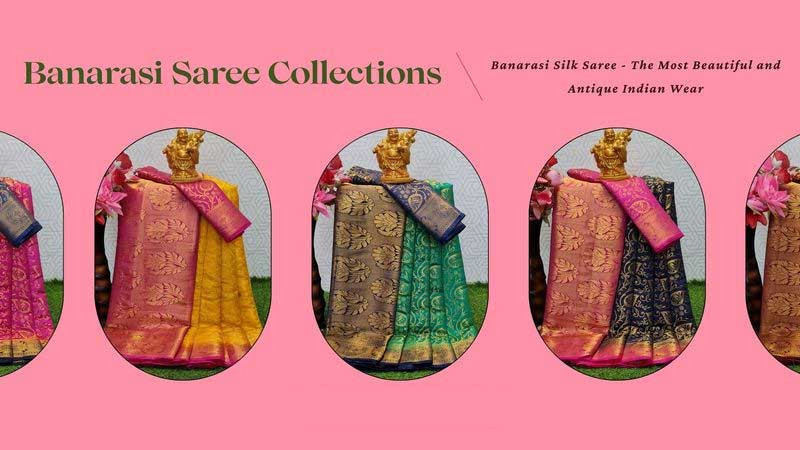Worldwide free shipping, On Orders from all item

The history of the Banarasi silk saree is very old, this saree got its Banarasi name from the famous city of Varanasi or Banaras in India. Varanasi, also called Banaras, is an ancient city where Banarasi sarees are made. Sarees from this region are renowned for their gold and silver brocade or zari, fine silk, and opulent embroidery. Because of these intricate engravings, the silk sarees are relatively heavy due to their fine weave and intricate designs.
Their special characteristics are intricate intertwining floral and foliate motifs, kalga and bel, a string of upright leaves called Jhallar at the outer, edge of the border is a characteristic of these sarees. In addition to gold work, compact weaving, small details, metallic visual effects, pallus, jal (a net-like pattern), and mina work, the work features gold work, compact weaving, and figures with small details.
Depending on the intricacy of its designs and patterns, a saree can take 15 days to a month and sometimes up to six months to complete. Banarasi sarees are mostly worn by Indian women on formal occasions such as when attending a wedding and are expected to be complemented by the woman's finest jewelry.
The cotton textile industry in Banaras was described as thriving by Ralph Fitch (1583–91). Banaras' brocades and Zari textiles were first mentioned in the 19th century. Silk brocade weaving probably began in Banaras in the seventeenth century as a result of the migration of Gujarati silk weavers during the famine of 1603. This is likely to have developed in excellence during the 18th and 19th centuries. It was in Banaras that gold and silver threads were used to weave brocades with intricate designs during the Mughal era.
The traditional Banarasi saree is made by the cottage industry for about 1.2 million people associated directly or indirectly with the handloom silk industry of the region around Varanasi. This region encompasses Gorakhpur, Chandauli, Bhadohi, Jaunpur, and Azamgarh districts.
In the last few years, a variety of independent, Varanasi-based brands have emerged to revive the Banarasi saree and bring them directly to mainstream consumers, including Ekaya, Tilfi Banaras, and HKV Benaras among others.
Over the years, the Banarasi silk handloom industry has been incurring huge losses because of competition from mechanized units producing the Varanasi silk sarees at a faster rate and a cheaper synthetic alternative to silk has also become a source of competition.
In 2009, after two years of wait, weaver associations in Uttar Pradesh secured Geographical Indication (GI) rights for the ‘Banaras Brocades and sarees’. An intellectual property right that identifies a specific region as the origin of a good is a geographical indication (GI). This is because a given quality, reputation, or another characteristic of the product is essentially attributable to its geographical origin.
GI certificates classify Banarasi products into four categories (23–26), namely silk brocades, textile goods, silk sarees, dress materials, and silk embroidery. The most important aspect of this is that no saree or brocade can be legally sold as a Banaras saree or brocade outside of the six districts, Varanasi, Mirzapur, Chandauli, Bhadohi, Jaunpur, and Azamgarh are some of the major cities of Uttar Pradesh.
Before this, in July 2007, nine organizations, Banaras Bunkar Samiti, Human Welfare Association (HWA), joint director industries (eastern zone), director of handlooms and textiles Uttar Pradesh Handloom Fabrics Marketing Cooperative Federation, Eastern UP Exporters Association (EUPEA), Banarasi Vastra Udyog Sangh, Banaras Hath Kargha Vikas Samiti and Adarsh Silk Bunkar Sahkari Samiti, had applied to the Chennai-based Geographical Indication Registry of the Indian government, supported by UNCTAD (United Nations Conference on Trade and Development).
There are four main varieties of Banarasi saree, which include pure silk (Katan), Organza (Kora) with Zari and silk; Georgette, and Shattir, and according to the design process, they are Categories include Jangla, Tanchoi, Vaskat, Cutwork, Tissue, and Butidar.
Due to the pollution caused by chemical dyes in the Ganges River caused by a large number of silk dyeing units in the trade, natural dyes are being used more commonly. A research team from the Indian Institute of Technology, Banaras Hindu University (IIT-BHU) used the technique of solvent extraction and enzymatic extraction to develop natural colors from plants, flowers, and fruits including acacia, butea (Palash), madder, marigold, and pomegranate (anar).
The increasingly errant and erratic electric power supply, which leads to the electric-powered looms sitting idle for more significant parts of the day, has made it difficult for the weavers to complete the sarees in a short time; consequently, their earnings are affected. The market has also become flooded with look-alike Banarasi sarees. These sarees are mass-produced in China on massive looms and therefore retail at meager prices.
Banarasi Saree is the perfect choice for a special occasion. With its intricate, colorful designs, it's a beautiful way to show off your taste and style. Whether you're dressing up for a formal event or just looking for something special to wear, a banarasi saree is a great choice.
What is Banarasi saree?
Banarasi saree is a type of sari, a traditional garment worn in India. It is made from delicate, heavy silk fabric with intricate embroidery.
What is the difference between Banarasi and other sarees?
Banarasi sarees are famed for their intricate gold and silver brocade or zari, fine silk, and opulent embroidery. Because of these intricate engravings, Banarasi sarees are relatively heavy due to their fine woven and intricate designs.
Who were the Mughals?
The Mughals were a Muslim dynasty that ruled over parts of the Indian subcontinent from 1526 to 1857.
What is Banaras?
Banaras is a city in Uttar Pradesh, India.
What is the difference between a saree and a salwar kameez?
A saree is a traditional Indian dress that is typically worn by women and is much more elaborately decorated than a salwar kameez. A salwar kameez is a knee-length dress that is typically worn by women in India and Pakistan.